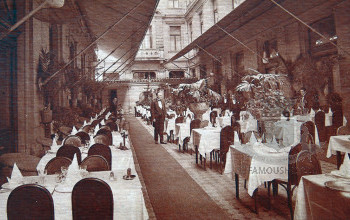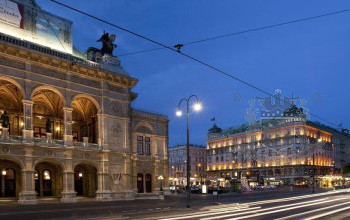From Trunks to Trolleys - A Short History of Luggage
( words)
A Short History of Luggage: From Trunks to Trolleys
(blog in progress - to add to this knowledge base please write to editor at famoushotels dot org)
Luggage has evolved dramatically over centuries, from simple trunks to modern, lightweight carry-ons. This post-in-progress explores the history of luggage, focusing on the evolution of materials, luxury travel, and famous luggage brands. From the days when servants and porters carried trunks to the modern trolley effortlessly gliding over marble floors, luggage tells a story of how we travel.
1. Evolution of Materials
In the early days of travel, luggage was not just a tool for carrying belongings but a reflection of one's social status. In the 18th and 19th centuries, wooden trunks reinforced with leather and metal were popular, often carried by servants or porters. Aristocrats and wealthy travellers required trunks large enough to carry entire wardrobes, and such pieces were often crafted from the finest materials.
As travel modernised in the 20th century, lighter materials such as aluminium and plastic replaced heavy wood and leather. Today, polycarbonate, known for its balance of strength and weight, dominates the luggage industry. Modern travellers seek not only durability but also ease of transport.
2. Luxury Travel and the Rise of Trunks
In the golden age of travel, luxury was paramount. During the era of postcoach and horse-drawn carriages, well-to-do travellers didn’t carry their own belongings. Instead, a team of porters and servants handled the task, ensuring that wardrobes filled with gowns, hats, and accessories arrived intact at grand destinations.
Celebrities like Marlene Dietrich were known for travelling with up to 12 pieces of luggage, including her famous hat boxes. These were not mere suitcases but bespoke creations, often designed by legendary houses such as Louis Vuitton. Each piece was a testament to the craftsmanship of the time: leather, brass locks, and gold embellishments were standard. These were items to be displayed, not hidden.
3. The Golden Age of Travel
The late 19th and early 20th centuries marked the height of luxury travel. The grand hotels and luxury liners of this era catered to an elite clientele that expected the highest standards. Trunks were transported by ship, rail, or carriage, often filling entire compartments.
Porters carried luggage into lavish suites, arranging belongings with precision. The aristocracy, diplomats, and stars of the silver screen expected nothing less. A journey was not merely a transfer from point A to point B but an experience in itself, and luggage was a critical part of that experience.
4. From Trunks to Trolleys: Modern Luxury
Today, the world of luxury travel has evolved. While the need for massive trunks has disappeared, the desire for refined travel accessories has not. In the lobby of a grand, historic hotel, the sound of a four-wheeled trolley gliding over polished marble floors signifies the ease of modern luxury. Porters are no longer required to carry heavy trunks, as sleek, lightweight hand luggage trolleys now serve that purpose.
Guests no longer rely on an army of servants, yet the elegance of travel remains. The luggage may be lighter, but the legacy of travelling in style continues to live on in the world’s most famous historic hotels.
The Extended Journey: Seasons Away
In earlier times, journeys often took weeks or even months. Travellers would move not just for a short holiday but for an entire season. The wealthy required entire wardrobes, suited for every occasion, from morning coats to night gowns, black tie attire, and evening wear.
Servants played a critical role in ensuring the smoothness of their master’s travel experience. They often arrived a day earlier to unpack trunks, ensuring that each item was perfectly placed in the wardrobe, the linens were pressed, and everything was in order before the master arrived. Every detail was attended to, with the highest standards of elegance and precision.
The Modern-Day Glamour: Porters and Private Planes
Still today, in the lobbies of grand hotels, it is not unusual to see a matching set of ten exquisite suitcases waiting to be loaded into a private plane. The tradition of refined travel persists, and though the luggage has become lighter, the grandeur has remained intact.
When such an occasion arises, the porters make certain to be on duty, ready to handle the luggage of these discerning travellers. Whether it’s whisked away to a private jet or carefully placed in a luxury suite, the timeless elegance of travel is never lost.
The leading luxury luggage producers in the world:
Bric’s – Italy, Como
An Italian luxury luggage company blending elegance and practicality.
Fendi – Italy, Rome
A renowned fashion house producing high-end luggage and accessories.
Globe-Trotter – United Kingdom, London
Established in 1897, known for its handmade lightweight suitcases.
Goyard – France, Paris
One of the oldest Parisian trunk-makers, famed for its exclusivity and craftsmanship.
Hartmann – United States, Milwaukee, Wisconsin
Founded in 1877, known for luxury leather goods and durable luggage.
Louis Vuitton – France, Paris
Synonymous with luxury travel since 1854, famed for its monogrammed trunks.
Montblanc – Germany, Hamburg
Known for pens, watches, and luxury luggage with a focus on craftsmanship.
Mossman Trunks – United Kingdom, Leeds
A heritage brand known for its durable, handmade trunks since the 1930s.
Prada – Italy, Milan
A luxury fashion brand producing high-end travel accessories and minimalist luggage.
Rimowa – Germany, Cologne
Famous for its distinctive grooved aluminium suitcases, established in 1898.
Samsonite – United States, Denver, Colorado
Founded in 1910, known for innovative, durable luggage designs.
Smythson – United Kingdom, London
Known for its elegant leather goods and luxury luggage.
T. Anthony – United States, New York City
Founded in 1946, known for handcrafted luggage favoured by celebrities and royalty.
Tumi – United States, Edison, New Jersey
Known for practical and innovative designs, catering to luxury and business travellers.
Valextra – Italy, Milan
An Italian luxury brand known for minimalist, high-end leather goods and luggage.
Zero Halliburton – United States, Los Angeles, California
Known for sleek, durable aluminium cases, founded in 1938 by American industrialist Erle P. Halliburton, the brand originally designed cases to protect delicate equipment in harsh environments. Its iconic aluminium briefcases and luggage became popular for their durability and security, even being used by NASA to carry lunar rock samples back to Earth. Today, Zero Halliburton remains a symbol of high-end, secure, and stylish travel gear, combining aerospace-grade materials with modern design.












